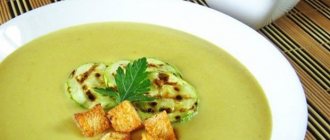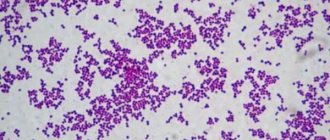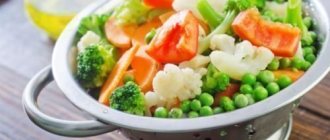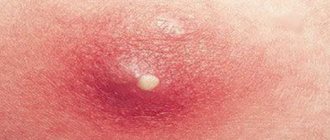general description
Dermatitis is an inflammatory reaction of the skin to an external irritant.
Types of dermatitis:
- contact type of dermatitis occurs when an irritating substance comes into direct contact with the skin;
- toxicerma - the irritant has entered the body and affects it from the inside;
- seborrhea;
- allergy;
- eczema.
Causes:
The most common causes of simple dermatitis can be radiation and temperature exposure, pressure and friction of the skin, contact with acid and alkali, and biological burns from plants. Allergic dermatitis appears some time after contact with the irritant. Atopic dermatitis can be transmitted genetically and occurs when exposed to irritants in food, air, or direct contact.
Symptoms:
simple forms of dermatitis manifest themselves in the form of pain, burning, itching and blisters on the skin, while chronic forms are accompanied by the appearance of swelling, peeling, cracks, and necrosis of the skin.
General rules
Among inflammatory skin diseases, dermatitis occupies a large share, the most common forms of which are atopic and seborrheic dermatitis . Despite the differences in the etiology and pathogenesis of these forms of dermatitis, the most important element in the treatment of these diseases is a hypoallergenic diet.
Hypoallergenic diet for atopic dermatitis
The main factor in the development of atopic dermatitis (AD) is an inherited predisposition to allergies, which is accompanied by increased production of total immunoglobulin E (IgE), generalized hypersensitivity and a specific reaction of the body to allergens. Hereditary predisposition is realized through a system of various causal factors (triggers) and environmental factors. Atopic dermatitis in the vast majority of cases is caused by food allergens. The most important causal allergens in adults are cow's milk proteins, chicken eggs, fish and seafood, cereals, soy proteins, red-orange vegetables and fruits, and nuts. It is against the background of food allergy, which is a factor of initial sensitization, that the body’s hypersensitivity to other allergens is formed through the mechanism of cross-reactions.
For children, the high antigenic load on the fetus is of great importance during the pathological course of pregnancy , with improper nutrition of the mother during lactation, early introduction of complementary foods or transfer to artificial feeding with the introduction of foods in the diet that are not appropriate for the child’s age, as well as pathology of the gastrointestinal tract and dysbiosis intestines, which causes increased absorption of various antigens .
The diet of a patient with atopic dermatitis is based on the principle of elimination - excluding foods and dishes from the diet:
- containing causally significant and cross allergens;
- having high sensitizing activity;
- including artificial food additives ( antioxidants , dyes, preservatives, flavors);
- promoting the release of histamine (chocolate, coffee, orange juice, cow's milk, wheat bran);
- containing a large amount of biogenic amines (histamine carriers) - tomatoes, strawberries, cocoa, legumes, hazelnuts, tuna, cheeses, smoked meats, spinach, herring fillets.
An elimination diet is selected for each patient individually, taking into account his “personal” food allergens and the list of “potentially allergenic foods,” as well as the stage of the disease.
In the acute period, the basis of the diet consists of foods with weak allergenic activity: lean beef, boiled chicken, pumpkin (light colors), squash, zucchini, offal (liver, kidneys, tongue), turnips, garden greens, green apples, cucumber , fermented milk products, low-fat cottage cheese, oatmeal, rice and pearl barley, plums, gooseberries, white currants, watermelon, olive and sunflower oil, pears, dried fruits, butter. At the same time, individual food allergens (if known) are excluded.
When preparing dishes during this period, you must follow a number of rules:
- the allergic activity of products is significantly reduced by heat treatment, so it is necessary to minimize the consumption of raw vegetables and fruits;
- Before eating, potatoes should be kept in cold water for several hours to reduce the starch content;
- porridge must be cooked in the third water - after boiling, the water must be drained and new water must be poured in, repeat twice;
- When preparing broths, vegetable purees and soups, the first water after boiling should also be drained.
If the allergen product is not known, then to identify it, a rotation diet , the essence of which is to divide the food products into several groups (meat, vegetables, dairy, cereals, fruits). The basic principle of this diet is to include in the daily diet for four days only one product from each group (1 type of meat, 1 type of cereal, 1 type of vegetable/fruit, 1 type of lactic acid products, 1 type of cereal). Repetition of any product is allowed only from the 5th day. This way you monitor reactions to products. If any product in the food set arouses your suspicions, try introducing it into the diet again in another set. If the reaction occurs again, it must be excluded from your diet. For analysis, it is recommended to keep a food diary.
The duration of a strict diet for an adult patient should be about 3 weeks and for children - 10 days. The fact of persistent disappearance of the symptoms of the disease can serve as a guide. Next, the diet is expanded to include foods with average allergenic activity.
First, white bread, boiled pork and lean white fish, fresh onions, green/yellow vegetables and fruits are introduced, and if there is no negative reaction, orange and red fruits/vegetables are introduced, as well as freshly squeezed juices, compotes and fruit purees. Thus, the basic diet of a patient with atopic dermatitis is formed. Products with a high allergic potential (eggs, milk, seafood, fish, citrus fruits, melon, chocolate, fish caviar, tomatoes, honey, nuts, strawberries), but important in terms of micronutrient content and energy significance, can be tried to be introduced gradually, one at a time and starting with small quantities. And, based on the body’s reaction to them, decide the possibility of including them in the basic diet. The following table gives some idea of the allergenic potential of products.
| Allergenic potential of products | Products |
| High degree of allergenic activity | Cow's milk, chicken egg, crustaceans, chocolate, cheese, fish, coffee, nuts, mustard, wheat, strawberries, strawberries, raspberries, beets, grapes, persimmons, melon, cocoa, red caviar, tomatoes, pomegranates, celery, black currants, carrots, pineapples, blackberries, spices, sauces, citrus fruits, honey, mushrooms, canned and pickled foods, smoked meats, carbonated and alcohol-containing drinks. |
| Average degree of allergenic activity | Turkey, pork, rabbit, potatoes, rice, peas, apricots, peaches, cranberries, corn, green peppers, buckwheat, bananas. |
| Weak degree of allergenic activity | Beef (low-fat varieties), lamb, boiled chicken, pumpkin (light colors), turnips, zucchini, squash, fermented milk products, green and yellow apples, gooseberries, plums, white currants, garden herbs, butter, green cucumber, watermelon , offal (liver, tongue, kidneys), almonds, pearl barley, rice, oatmeal, olive pears, and sunflower oil, dried fruits. |
The diet of a patient with atopic dermatitis should limit foods containing easily digestible carbohydrates: confectionery, honey, sugar, jam, sweets. It is recommended to replace sugar completely with xylitol , saccharin , and aspartame . The diet should include foods rich in calcium (fermented milk products, cottage cheese), which have a pronounced antiallergic effect, and limit foods rich in oxalic acid , which interferes with the absorption of calcium. Strong broths, spicy and smoked dishes, sauces and seasonings are excluded. Salt and any salty foods are subject to restrictions.
In case of allergic dermatitis , the trigger for the development of which is not food factors, but direct contact with the allergen (through skin contact with it), it is extremely important to first eliminate the causative factor and the time of its exposure. Contact sensitization of the body occurs in both adults and children, even in the first months of life. The cause is most often chemical ingredients and dyes in plastic products, toys, which cause rashes and redness on the hands and face, and the composition of clothing.
The difficulty in identifying a contact allergen factor lies in the fact that it is very difficult to trace the connection with the triggering action of any chemical reagent, since the aftereffect is often delayed. That is, contact with the allergen has already been eliminated, and clinical manifestations of dermatitis develop after 24-48 hours.
In any case, for atypical allergic contact dermatitis, a general hypoallergenic diet is indicated. The same anti-allergenic nutrition is required for oral dermatitis and treatment of Dühring's dermatitis . However, dietary nutrition for Dühring's dermatitis additionally provides for the complete exclusion from the diet of foods containing gluten (gluten), which is a complex protein found in cereals (wheat, rye, barley). The diet for oral dermatitis, in addition to the general requirements for a hypoallergenic diet, includes the exclusion of hot, hot, spicy foods and foods containing coarse dietary fiber to reduce irritation of the affected part of the skin around the oral cavity.
Seborrheic dermatitis is caused by an increase in the secretion and change in the composition of sebum, accompanied by hyperactivation of the fungal microflora of the genus Malassezia and inflammation of the skin. With seborrheic dermatitis, areas of shiny, greasy, thickened skin and dandruff on the head with areas of erythema on the skin, which are accompanied by mild itching, appear on the face, head, and back. Nutrition for seborrhea should be physiologically complete with a menu limit of white bread, animal fats, refined carbohydrates, salt, hot seasonings and spices, and foods containing a lot of cholesterol .
The basis of the diet should be dairy products, low-fat fish, boiled meat, brown bread and foods rich in fiber (porridge, vegetables/fruits).
Diet for contact dermatitis
Contact dermatitis is a type of allergic dermatitis, so nutritional recommendations for these diseases are almost the same.
The most important points in building nutrition are excluding from the patient’s diet those dishes that provoke the development of allergies, as well as providing the body with vitamins and other useful elements. The first rule of a diet for contact dermatitis is compliance with the drinking regime. A sufficient amount of fluid is necessary to accelerate the removal of toxic and sensitizing substances from the body.
The remaining nutritional standards are generally accepted for allergic diseases. This means giving up coffee and chocolate, alcohol, soda and packaged juices, citrus fruits, spicy and fried foods, canned food and marinades, honey and nuts. All of these products can trigger the development of allergies in hypersensitive individuals.
Be careful when consuming whole milk products, eggs and seafood
What can you do while following this diet?
- fresh fermented milk products;
- lean meat;
- whole grain bread;
- vegetables, dill, parsley, salad;
- porridges and soups from cereals (buckwheat, oatmeal, rice);
- all varieties of apples and pears;
- weakly brewed tea, dried fruit compote, rosehip infusion.
And let us remind you once again about the need to drink enough water, still and not tap water, but plain and clean water. You can buy it in a store, or take it from a proven natural source: a well or spring.
[], [], [], []
Authorized Products
The first courses are prepared in a weak vegetable broth without frying with the addition of garden herbs. The diet includes lean boiled (without skin) or stewed dietary meat of turkey, chicken or rabbit. As a side dish, it is allowed to use potatoes pre-soaked in water, boiled in water in the form of mashed potatoes or in separate pieces.
Among the cereals, the diet may include buckwheat, wheat and oatmeal. From the group and dairy products - low-fat fermented milk products, yogurt without additives, fresh low-fat cottage cheese. It is allowed to include bran/whole grain bread, dry biscuits, and durum wheat pasta in the diet.
Fats must include vegetable oils (sunflower or olive). Vegetables: cucumber, onion, lettuce, stewed/boiled zucchini, boiled or stewed cabbage.
Table of permitted products
| Proteins, g | Fats, g | Carbohydrates, g | Calories, kcal | |
Vegetables and greens | ||||
| eggplant | 1,2 | 0,1 | 4,5 | 24 |
| zucchini | 0,6 | 0,3 | 4,6 | 24 |
| cabbage | 1,8 | 0,1 | 4,7 | 27 |
| broccoli | 3,0 | 0,4 | 5,2 | 28 |
| Brussels sprouts | 4,8 | 0,0 | 8,0 | 43 |
| cauliflower | 2,5 | 0,3 | 5,4 | 30 |
| green onion | 1,3 | 0,0 | 4,6 | 19 |
| bulb onions | 1,4 | 0,0 | 10,4 | 41 |
| cucumbers | 0,8 | 0,1 | 2,8 | 15 |
| squash | 0,6 | 0,1 | 4,3 | 19 |
| parsley | 3,7 | 0,4 | 7,6 | 47 |
| salad | 1,2 | 0,3 | 1,3 | 12 |
| celery | 0,9 | 0,1 | 2,1 | 12 |
| soybeans | 34,9 | 17,3 | 17,3 | 381 |
| asparagus | 1,9 | 0,1 | 3,1 | 20 |
| Jerusalem artichoke | 2,1 | 0,1 | 12,8 | 61 |
| dill | 2,5 | 0,5 | 6,3 | 38 |
| beans | 7,8 | 0,5 | 21,5 | 123 |
| garlic | 6,5 | 0,5 | 29,9 | 143 |
| lentils | 24,0 | 1,5 | 42,7 | 284 |
Fruits | ||||
| pears | 0,4 | 0,3 | 10,9 | 42 |
| nectarine | 0,9 | 0,2 | 11,8 | 48 |
| peaches | 0,9 | 0,1 | 11,3 | 46 |
| apples | 0,4 | 0,4 | 9,8 | 47 |
Berries | ||||
| gooseberry | 0,7 | 0,2 | 12,0 | 43 |
| black currant | 1,0 | 0,4 | 7,3 | 44 |
Nuts and dried fruits | ||||
| flax seeds | 18,3 | 42,2 | 28,9 | 534 |
| sunflower seeds | 20,7 | 52,9 | 3,4 | 578 |
Cereals and porridges | ||||
| buckwheat (kernel) | 12,6 | 3,3 | 62,1 | 313 |
| semolina | 10,3 | 1,0 | 73,3 | 328 |
| oat groats | 12,3 | 6,1 | 59,5 | 342 |
| cereals | 11,9 | 7,2 | 69,3 | 366 |
| wheat bran | 15,1 | 3,8 | 53,6 | 296 |
Raw materials and seasonings | ||||
| basil | 2,5 | 0,6 | 4,3 | 27 |
Dairy | ||||
| dairy products | 3,2 | 6,5 | 4,1 | 117 |
| kefir 0% | 3,0 | 0,1 | 3,8 | 30 |
| kefir 1% | 2,8 | 1,0 | 4,0 | 40 |
Cheeses and cottage cheese | ||||
| cottage cheese 0.6% (low fat) | 18,0 | 0,6 | 1,8 | 88 |
| curd tofu | 8,1 | 4,2 | 0,6 | 73 |
Meat products | ||||
| boiled beef | 25,8 | 16,8 | 0,0 | 254 |
| beef stew | 16,8 | 18,3 | 0,0 | 232 |
Bird | ||||
| boiled chicken | 25,2 | 7,4 | 0,0 | 170 |
| steamed chicken breast | 23,6 | 1,9 | 0,0 | 113 |
| boiled turkey fillet | 25,0 | 1,0 | — | 130 |
Fish and seafood | ||||
| seaweed | 0,8 | 5,1 | 0,0 | 49 |
Oils and fats | ||||
| butter | 0,5 | 82,5 | 0,8 | 748 |
| linseed oil | 0,0 | 99,8 | 0,0 | 898 |
| olive oil | 0,0 | 99,8 | 0,0 | 898 |
| sunflower oil | 0,0 | 99,9 | 0,0 | 899 |
Non-alcoholic drinks | ||||
| mineral water | 0,0 | 0,0 | 0,0 | — |
| instant chicory | 0,1 | 0,0 | 2,8 | 11 |
| green tea | 0,0 | 0,0 | 0,0 | — |
Juices and compotes | ||||
| rose hip juice | 0,1 | 0,0 | 17,6 | 70 |
| * data is per 100 g of product | ||||
Sample diet menu
The diet of an adult with skin diseases is based on the principles:
- A gentle diet for the liver, since this organ is a filter of toxins and harmful substances entering the body;
- Complete abstinence from alcohol - ethyl drinks have a detrimental effect on human immunity;
- Desensitizing nutrition involves drinking plenty of fluids, consuming bran and fiber, as well as large amounts of vegetables and fruits, and excluding sweets;
- In case of fungal infection of the skin, dairy products should be excluded, since lactose provokes the proliferation of Candida fungi on the epidermis;
- For eczematous dermatitis on the hands, eat exclusively soups and boiled porridges in water.
During the treatment period, it is important to saturate the body with folic acid. This will help improve metabolic processes in the epidermis and restore damaged areas
Antioxidants include vitamin E and the microelement selenium - these are substances that eliminate the amount of free radicals in the blood. A lack of zinc causes dry skin, increased flaking and itching. To replenish the vitamin composition, it is recommended to take special pharmacy complexes.
Sample dietary menu for one day:
- Breakfast – 0% fat cottage cheese and herbal tea;
- Snack – baked apples;
- Lunch – soup or porridge in vegetable broth with crackers;
- Afternoon snack – kefir;
- Dinner – puree of zucchini, potatoes, cabbage with the addition of boiled fish.
Fully or partially limited products
A hypoallergenic diet involves the exclusion of meat and fish broths and dishes prepared using them. It is prohibited to consume any fatty varieties of red meat, chicken eggs, smoked meats, most sausages, duck, seafood (mussels, shrimp, squid), honey and honey products, all salty foods, canned food, pickled vegetables, cream, cooking and animal fats, sour cream , sweet curds, salty and fatty cheeses.
Excluded: sugar, ice cream, confectionery, jam, honey, sweets, jams. Semolina, white rice, pasta, and soy are also subject to restrictions. The menu of a hypoallergenic diet should not include products containing any food additives, fruit tea, fruit/vegetable juices from prohibited berries, sweet carbonated drinks and all drinks containing carbon dioxide and alcohol.
All seasonings (mayonnaise, ketchup, mustard, horseradish), vinegar, eggplant, mushrooms, pineapple, melon, butter dough, as well as all fruits/vegetables of red and orange color (carrots, tangerines, beets, tomatoes, red apples) are also excluded from the diet , strawberries, oranges, radishes, radishes, strawberries), nuts, coffee.
Table of prohibited products
| Proteins, g | Fats, g | Carbohydrates, g | Calories, kcal | |
Vegetables and greens | ||||
| carrot | 1,3 | 0,1 | 6,9 | 32 |
| salad pepper | 1,3 | 0,0 | 5,3 | 27 |
| tomatoes | 0,6 | 0,2 | 4,2 | 20 |
Fruits | ||||
| oranges | 0,9 | 0,2 | 8,1 | 36 |
| bananas | 1,5 | 0,2 | 21,8 | 95 |
| pomegranate | 0,9 | 0,0 | 13,9 | 52 |
| grapefruit | 0,7 | 0,2 | 6,5 | 29 |
| lemons | 0,9 | 0,1 | 3,0 | 16 |
| mango | 0,5 | 0,3 | 11,5 | 67 |
| tangerines | 0,8 | 0,2 | 7,5 | 33 |
Berries | ||||
| grape | 0,6 | 0,2 | 16,8 | 65 |
| Red currants | 0,6 | 0,2 | 7,7 | 43 |
Nuts and dried fruits | ||||
| nuts | 15,0 | 40,0 | 20,0 | 500 |
| raisin | 2,9 | 0,6 | 66,0 | 264 |
Cereals and porridges | ||||
| white rice | 6,7 | 0,7 | 78,9 | 344 |
Confectionery | ||||
| jam | 0,3 | 0,2 | 63,0 | 263 |
| jam | 0,3 | 0,1 | 56,0 | 238 |
| candies | 4,3 | 19,8 | 67,5 | 453 |
| pastry cream | 0,2 | 26,0 | 16,5 | 300 |
Ice cream | ||||
| ice cream | 3,7 | 6,9 | 22,1 | 189 |
Cakes | ||||
| cake | 4,4 | 23,4 | 45,2 | 407 |
Chocolate | ||||
| chocolate | 5,4 | 35,3 | 56,5 | 544 |
Raw materials and seasonings | ||||
| mustard | 5,7 | 6,4 | 22,0 | 162 |
| ketchup | 1,8 | 1,0 | 22,2 | 93 |
| mayonnaise | 2,4 | 67,0 | 3,9 | 627 |
| honey | 0,8 | 0,0 | 81,5 | 329 |
| vinegar | 0,0 | 0,0 | 5,0 | 20 |
Dairy | ||||
| condensed milk | 7,2 | 8,5 | 56,0 | 320 |
| cream | 2,8 | 20,0 | 3,7 | 205 |
| sour cream 30% | 2,4 | 30,0 | 3,1 | 294 |
| sour cream 40% (fat) | 2,4 | 40,0 | 2,6 | 381 |
Cheeses and cottage cheese | ||||
| cheese | 24,1 | 29,5 | 0,3 | 363 |
| dor blue cheese | 21,0 | 30,0 | 0,0 | 354 |
| blue cheese | 17,6 | 31,0 | 1,8 | 363 |
| amber processed cheese | 7,0 | 27,3 | 4,0 | 289 |
| cottage cheese 18% (fat) | 14,0 | 18,0 | 2,8 | 232 |
Meat products | ||||
| fatty pork | 11,4 | 49,3 | 0,0 | 489 |
| pork fat | 1,4 | 92,8 | 0,0 | 841 |
| salo | 2,4 | 89,0 | 0,0 | 797 |
| mutton | 15,6 | 16,3 | 0,0 | 209 |
Sausages | ||||
| smoked sausage | 16,2 | 44,6 | 0,0 | 466 |
| smoked sausage | 9,9 | 63,2 | 0,3 | 608 |
| sausages | 10,1 | 31,6 | 1,9 | 332 |
| sausages | 12,3 | 25,3 | 0,0 | 277 |
Bird | ||||
| smoked chicken | 27,5 | 8,2 | 0,0 | 184 |
| duck | 16,5 | 61,2 | 0,0 | 346 |
| smoked duck | 19,0 | 28,4 | 0,0 | 337 |
| goose | 16,1 | 33,3 | 0,0 | 364 |
Eggs | ||||
| chicken eggs | 12,7 | 10,9 | 0,7 | 157 |
Fish and seafood | ||||
| smoked fish | 26,8 | 9,9 | 0,0 | 196 |
| salted fish | 19,2 | 2,0 | 0,0 | 190 |
| Red caviar | 32,0 | 15,0 | 0,0 | 263 |
| black caviar | 28,0 | 9,7 | 0,0 | 203 |
| canned fish | 17,5 | 2,0 | 0,0 | 88 |
| semi-finished fish products | 12,5 | 6,7 | 14,7 | 209 |
| sardine | 20,6 | 9,6 | — | 169 |
| mackerel | 18,0 | 13,2 | 0,0 | 191 |
Oils and fats | ||||
| creamy margarine | 0,5 | 82,0 | 0,0 | 745 |
| coconut oil | 0,0 | 99,9 | 0,0 | 899 |
| palm oil | 0,0 | 99,9 | 0,0 | 899 |
| rendered beef fat | 0,0 | 99,7 | 0,0 | 897 |
| cooking fat | 0,0 | 99,7 | 0,0 | 897 |
| rendered pork fat | 0,0 | 99,6 | 0,0 | 896 |
Alcoholic drinks | ||||
| white dessert wine 16% | 0,5 | 0,0 | 16,0 | 153 |
| dry white wine | 0,1 | 0,0 | 0,6 | 66 |
| vodka | 0,0 | 0,0 | 0,1 | 235 |
| cognac | 0,0 | 0,0 | 0,1 | 239 |
| liquor | 0,3 | 1,1 | 17,2 | 242 |
| beer | 0,3 | 0,0 | 4,6 | 42 |
Non-alcoholic drinks | ||||
| cola | 0,0 | 0,0 | 10,4 | 42 |
| black coffee | 0,2 | 0,0 | 0,3 | 2 |
| Pepsi | 0,0 | 0,0 | 8,7 | 38 |
| sprite | 0,1 | 0,0 | 7,0 | 29 |
| tonic | 0,0 | 0,0 | 8,3 | 34 |
| energy drink | 0,0 | 0,0 | 11,3 | 45 |
Juices and compotes | ||||
| cranberry jelly | 0,0 | 0,0 | 13,0 | 53 |
| * data is per 100 g of product | ||||
What should you not eat?
All foods considered allergens are usually excluded from the diet. These include the following:
Honey. It cannot be consumed in its pure form or added to various dishes and drinks.
Eggs. Although this is a healthy product in principle, it can easily cause allergies.
It is especially important to limit their use for dermatitis in children.
Cocoa. This drink increases the load on the liver and can cause an exacerbation of dermatitis.
Whole milk
It is also an allergen and can cause a relapse.
Nuts. All types are excluded.
Citrus. Despite their benefits, these are highly allergenic products. Exotic fruits of red and orange colors are also prohibited.
Also, an exacerbation of the disease can be provoked by the consumption of smoked, fatty, fried, pickled foods. Seafood, caviar, and fatty meat are excluded. Spices, salt and sugar are limited. Do not drink alcohol, sweet juices, or carbonated drinks.
Each person’s body is individual, and you need to monitor the reaction to specific products. If a certain dish provokes signs of the disease, it must be excluded.
For children
Treatment of children with atopic dermatitis involves the elimination of causally significant food/non-food allergens, the role of which in exacerbating the disease has already been proven. The basis for exclusion from a child’s diet is the establishment of a connection between the disease and exposure to a causally significant allergen and sensitization to it identified according to the results of an allergological examination (positive skin testing or detection of specific immunoglobulins E ).
When in doubt, as well as in the presence of multiple food sensitization, provocative tests are performed with food products - suspected allergens - to confirm hypersensitivity. It is important to achieve complete exclusion of the allergen from the diet, taking into account its possible hidden presence in other foods and taking into account potential cross-reactivity.
The duration of the elimination diet should be 6–12 months and is determined individually. After this period, a repeat allergological examination is carried out, which determines the possibility of using an allergen product in the child’s diet. However, at the same time, the diet must correspond to the age-related nutritional needs of children and be balanced in proteins, fats and carbohydrates .
When transferring a child under one year of age to artificial/mixed feeding, one should not include in the diet mixtures based on whole cow's milk, as well as milk from other animals (goat, sheep) and mixtures based on partial hydrolysis of cow's milk protein and soy protein. It is better to use mixtures based on a high degree of whey protein hydrolysis: Frisopep , Alfare , Nutrilon Pepti TSC , or casein hydrolysis: Frisopen AS , Pregestimil , Nutramigen .
If the effectiveness of diet therapy based on mixtures of highly hydrolyzed protein (after 2-4 weeks of use) and in severe forms of the disease is low, it is recommended to use mixtures based on amino acids ( Neokey ). A hypoallergenic diet for older children is based on similar principles, but you should not overuse the child on it for a long time, as this can cause a disruption in his physical development. A strictly restrictive diet is recommended to be used only during the period of exacerbation of atopic dermatitis, no more than 7-10 days, and after identifying and eliminating causative allergenic foods from the diet, it is necessary to transfer the child to an individual hypoallergenic diet.
Diet for allergies in adults
Diet for adults can be of two types: nonspecific and elimination. The first type of diet is based on excluding all the most allergenic foods from the menu; elimination involves excluding only obviously allergenic foods for a particular person.
Non-specific diet
Nutrition for allergies in adults according to the type of nonspecific diet is suitable for all types of allergic diseases. In this case, it is necessary to remove foods that are potential allergens, such as chocolate and citrus fruits, from the person’s diet.
Food products that are less allergenic should simply be limited. Thus, the patient is recommended to follow a strict diet, the menu of which includes exclusively hypoallergenic foods.
What foods should make up the diet for a non-specific diet, and which ones should be abandoned:
- YOU CAN: oil of animal and vegetable origin; fermented milk products; low-fat cheese (up to 40% fat); onion; buckwheat, rice and corn cereals; pasta; cabbage; zucchini; lean meat (for example, rabbit), wholemeal bread.
- LIMITED: sugar; dishes with wheat flour.
- DON'T (highly allergenic): rich broths; semi-finished products; seafood; eggs; sauces; especially industrial preparation; honey; confectionery products with trans fats and artificial fillers; milk; nuts; tea; coffee.
A similar anti-allergy diet should be followed for two to three weeks until the main clinical manifestations of the disease are eliminated, for example, the disappearance of symptoms of urticaria and allergic dermatitis on the skin in adults.
Elimination diet for allergies
This type of diet is based on removing a specific, precisely known allergen from the diet.
But to do this, it is necessary to first determine what exactly a person has an individual hypersensitivity reaction to. An elimination diet can be year-round if we are talking about food allergies, or practiced on a seasonal basis if a person suffers from hay fever.
For example, if it is a food allergy, it is enough to create a diet that excludes the known allergen. If we are talking about seasonal allergies, then certain foods are removed from the diet during the flowering period of individual plants.
If you are allergic to milk, you must follow a dairy-free diet, in which there is no place for cow's milk, milk protein, baked goods and dairy-based sweets. An elimination diet for food allergies in adults to eggs excludes the consumption of foods containing egg whites and yolks, in particular mayonnaise, pasta, baked goods, etc. All options for this diet are discussed individually with your doctor.
Reviews and results
According to patient reviews, eliminating causally significant food allergens from the diet can reduce the clinical manifestations of atopic dermatitis , and in chronic cases, lengthen periods of remission.
- “... Allergic diathesis in my daughter first appeared at the age of 6 months after the introduction of complementary foods based on cow's milk. I had to switch the child to special artificial formulas. However, diathesis appeared periodically for up to 2 years. Obviously, the child reacted to some other product, but we could not establish it for sure. After two years of diathesis, the rashes stopped on their own, but we, on the advice of the doctor, still adhere to a hypoallergenic diet”;
- “... My baby developed allergic dermatitis when complementary foods were introduced. We found out that this is a reaction to juices. The juices were stopped, and the condition immediately improved. At 6 months of age, I again tried to introduce various juices into the diet one by one and again had a negative reaction to almost all of them. It is a pity that the child is deprived of the opportunity to receive them. The doctor said that perhaps later the diathesis on juices will go away. We really hope so. I myself follow a hypoallergenic diet, and if I have a breakdown during the holidays, I drink sorbent and take a light antihistamine.”
Diet for dermatitis in adults
What should be considered when prescribing a diet for dermatitis in adults? It is known that the diet of an adult differs significantly from what a child eats.
First of all, it is alcohol, be it beer, or wine, or stronger drinks: they must be excluded.
The next step is to review your diet. Fried, salted, smoked dishes, fast food - exclude. Remember that we need to protect the body from some irritating factors that have a harmful effect inside the body when they enter it with food
For the same reason, be very careful when consuming foods containing honey, nuts, seafood, citrus fruits, soy products, as well as eggs and milk. Instead of sauces, use various types of vegetable oils (except peanut and sesame, they can cause allergies), as well as fermented milk products - sour cream, yogurt
Eat soups, cereals, vegetable dishes, and low-fat steamed cutlets. When preparing food, try not to add spices and seasonings, and add less salt and sugar: this will prevent fluid retention in the body.
When choosing products, be guided by the composition indicated on the package: the presence of preservatives, dyes, flavors, emulsifiers and other harmful substances can aggravate the course of dermatitis, so it is better to avoid such products.
All foods you eat must be fresh, vegetables and fruits must be well washed.
It’s good if a food allergen has been detected: be sure to eliminate it from your diet and never eat it again.
[], [], [], []
Mom's diet for atopic dermatitis in a baby
A child in the first years of life is extremely susceptible to the development of allergic reactions, because the small body is not yet sufficiently adapted to some new substances. Diathesis, atopic dermatitis - often young mothers cannot understand where this or that disease comes from. As a rule, the allergen enters the baby’s body through food. If your baby eats formula, this is most likely the reason. If the child is breastfed, the mother’s diet is to blame, because almost all substances consumed with food pass into breast milk, and from there into the baby’s body. Moreover, experts say that a woman should exclude some foods from her diet even in the last weeks of pregnancy, not to mention the period of breastfeeding.
What foods should be in a mother’s diet, and which ones should be excluded?
We offer you a list of products that are more likely than others to cause an allergic reaction:
- absolutely all citrus fruits (oranges, tangerines, limes, grapefruits, lemons);
- beekeeping products (honey, beebread, pollen, bees);
- fruits that do not grow in the region (exotic fruits);
- strawberries and strawberries, grapes;
- seafood, squid, crabs, lobsters, mussels;
- caviar;
- chicken eggs;
- whole milk;
- wheat and rye;
- cocoa beans and products made from them;
- nuts, nut butters and pastes;
- smoked meats, spices, sweets, products with chemical dyes and preservatives, including drinks.
Mom should eat in moderation, not overeat and not focus on any one product: food should be varied and nutritious.
Be careful about your baby’s nutrition: do not overfeed him, introduce new formulas and complementary foods gradually, starting with ½ tsp. It is advisable not to wean your baby until 1 year of age.
But give your baby clean water upon request: maintaining water balance is very important for the prevention of diathesis
What is dermatitis
The disease, which is defined as dermatitis, can be an independent or secondary manifestation of another disease. In fact, it is a skin reaction to psychological, internal or external stimuli. Dermatitis (local manifestations) and dermatoses (systemic diseases) often have a strong relationship. Common symptoms of different types of disease:
- itching (prurigo);
- redness (erythema);
- eczema (severe local rashes);
- exudation - release of fluid in places of localization or self-scratching;
- intensive exfoliation of the skin (desquamation).
The causes of dermatitis can be any factor (this is the problem of diagnostic determination of a specific provoking agent):
- conditioned stimuli - products that have an individual effect on the body of a particular person;
- unconditional - substances that necessarily cause irritation (acids, high or low temperatures, salts, alkalis);
- physical - friction, hyperhydration, ultraviolet, radiation, infrared radiation.
Hypoallergenic diet for atopic dermatitis
- Vegetables and meat are boiled rather than fried in oil with seasonings;
- Before cooking, cereals should be soaked for 30 minutes, then rinsed thoroughly with clean running water;
- Before eating raw vegetables and fruits, you need to peel them;
- Meat or fish broth must be cooked in several stages. Initially, the products are soaked in clean water for 1 hour, then the broth is boiled, drained and the next one is boiled (until transparent).
It has been proven that adults and children most often develop allergies to vegetables and fruits of rich scarlet colors. Therefore, tomatoes, strawberries, raspberries, and red currants should be excluded during the therapeutic diet.
When breastfeeding, avoid eggs, chocolate, citrus fruits, seafood, and sweets. It is not recommended to constantly consume the same foods, as a cumulative allergic reaction may develop. Before buying food in a supermarket, carefully read the ingredients - it should not contain dyes, preservatives, or emulsifiers.











